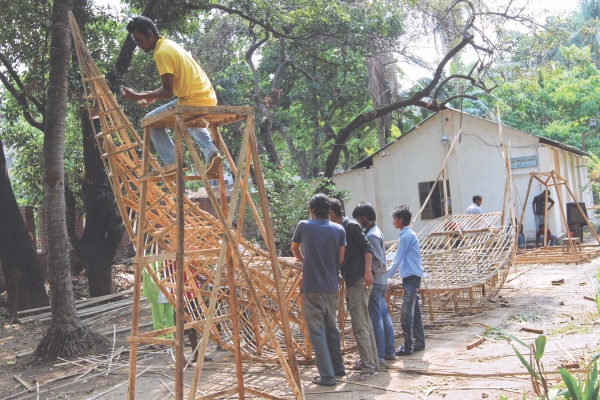| Home - Back Issues - The Team - Contact Us |
 |
| Volume 11 |Issue| 15 | April 13, 2012 | |
|
|
Festival A Bengali Parade Anika Hossain
The 14th of April is one day of the year when all Bangladeshis try to get in touch with their roots. Some of us put away our western wear and don red and white traditional outfits. We eat Bangladeshi food and listen to Bangladeshi music, we wear Bangladeshi flowers in our hair and exchange Bangladeshi greetings, and all this we do to celebrate a new Bengali year on the Bengali calendar that we don't really follow. Makes one wonder what all the fuss is about right? The obvious reason is for fun of course! Pohela Boishak, the first day of a new Bengali year, is always an occasion for celebration and festivities. Each year, there is a list of “must do's” on this day. The day long process of transforming oneself into a Bengali begins with a visit to Ramna Park at an ungodly hour in the morning to listen to deshi music. This is followed by a walk to Charukola (Fine Arts Institute of Dhaka University) to watch the yearly Pohela Baishakh parade, the Mongol Shobhajatra, an elaborate and colourful affair organised by students, which also happens to be the highlight of the day. An unthinkable amount of effort goes into this pageant, devised to remind us of our origins and traditions. The students of Charukola have been organising and taking part in this procession since 1989 but the level of enthusiasm and participation increases with each passing year. “This year, we have about 900 student volunteers working on the parade and the teachers of course help out as well,” says Nobendra Saha Nobo, a member of the organising committee, “Students are here from the Rajshahi and the Chittagong Charukola as well to participate.” The preparations which began on the 19th of March this year, is in full swing now at the Fine Arts Institute. Even the persistent rain storms haven't thwarted the enthusiasm of the volunteers, who are working day and night to complete their projects. A peek into the gates of Charukola will give one a glimpse of the giant sculptures that are currently being built for the parade. Students are using every inch of the ground floor and courtyard of the Fine Arts Institute to paint, sculpt, glue and mould their masterpieces.
“The theme every year is the same, we use folk motifs in our artwork,” says Manabendra Ghosh, a student specialising in sculpting at Charukola. “This year we have horses, elephants, tigers and bamboo and paper versions of traditional clay dolls (tepa putul) all of which are 15 to 16 ft tall. We also have a Shampan (boat) which is about 35 ft long and some sculptures of what we are calling aposhokti (evil forces) such as angry fanged and dark characters which are cylindrical and about 16 ft tall. I myself am working on one of these. They are meant to represent those who are against the freedom of the nation.” The parade will also consist of large paper and plaster moulded masks of kings and queens and different animals such as owls, rabbits and tigers. The classroom floors are strewn with these masks as students bend attentively over them with paintbrushes in hand. “I'm painting a mask of a queen,” says Jhumu, who is a student volunteer, “The preparations are the best part of the parade because of the fun involved in group work,” she comments. “Designing projects together and making sure they go smoothly is a good learning experience,” says M A Kader Parvez who is also a volunteer.
“This year we have made about 1000 masks, most of which are for sale as a part of the fund raising efforts for the parade,” says Nobendra Saha Nobo, “Some are for the parade, especially the paper mesh masks.” Selling masks and painted pottery is the main source of funding for this parade. The students also make watercolours and other paintings which they sell to raise money. “The sale starts about 7 to 10 days before Pohela Boishakh,” says Ghosh, “Many students also contribute their own money for this event, which goes to show how dedicated they are. Our most enthusiastic participants are first year students who have witnessed the parade first hand over the years or have seen it on TV or the papers.” All this effort eventually results in a fantastic parade full of kaleidoscopic sculptures and artwork made by students who are trying hard to remind us who we truly are and where we come from. It is definitely a grand way to celebrate the coming of a brand new Bengali year. Copyright
(R) thedailystar.net 2012 |


